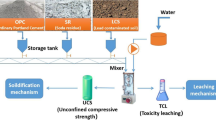Abstract
The cement-based solidification/stabilization (S/S) of nitrobenzene (NB) contaminated soils, with cement and lime as binders, sodium silicate solution and powder activated carbon (PAC) as additives, was optimized through an orthogonal experiment, and S/S efficiency was estimated by both leaching test and volatilization measurement. The leaching test results showed that the factors affecting S/S efficiency were NB concentration, cement-to-lime ratio and binder-to-soils ratio, in sequence. With increasing curing time, the leaching concentration of NB between different levels of the same factor in the orthogonal experiment decreased, and less than 9% NB leached out from the 28 d cured samples. The volatilization measurement results indicated that 0.5‰ of NB was volatilized during the mixing and curing processes for the samples without PAC in the 28 d cycle, whereas adding 2 wt% and 5 wt% PAC, with respect to the weight of contaminated soils, could reduce NB volatilization to half of its original values either during the mixing or curing process. The optimizing formula, that is, contaminated soils (dry weight):cement:lime = 100:25:25, with 5 wt% additional sodium silicate and 2 wt% additional PAC, was applied to the engineering application of NB contaminated soils. Both the leaching test results of the product and the ambient air quality monitoring results met related regulations during the treating process.
Similar content being viewed by others
References
Montgomery D M, Sollars C J, Perry R, Tarling S E, Barnes P, Henderson E. Treatment of organic-contaminated industrial wastes using cement-based stabilization/solidification—II. Microstructural analysis of the organophilic clay as a pre-solidification adsorbent. Waste Management & Research, 1991, 9(2): 113–125
Rivera-Austrui J, Borrajo MA, Martinez K, Adrados MA, Abalos M, van Bavel B, Rivera J, Abad E. Assessment of polychlorinated dibenzo-p-dioxin and dibenzofuran emissions from a hazardous waste incineration plant using long-term sampling equipment. Chemosphere, 2011, 82(9): 1343–1349
Hinshaw G D, Trenholm A R. Hazardous waste incineration emissions in perspective.Waste Management, 2001, 21(5): 471–475
Yao Z T, Li J H, Zhao X Y. Molten salt oxidation: a versatile and promising technology for the destruction of organic-containing wastes. Chemosphere, 2011, 84(9): 1167–1174
Huang C P, Dong C D, Tang Z H. Advanced chemical oxidation: Its present role and potential future in hazardous waste treatment. Waste Management, 1993, 13(5–7): 361–377
Vaidya R, Kodam K, Ghole V, Surya MR. Validation of an in situ solidification/stabilization technique for hazardous barium and cyanide waste for safe disposal into a secured landfill. Journal of Environmental Management, 2010, 91(9): 1821–1830
Tuncan M. Pilot field study of petroleum contaminated wastes stabilization. Fuel and Energy Abstracts, 1997, 38(4): 267
Marwa S A, Abir A. Stabilisation/solidification of synthetic petroleum drill cuttings. Journal of Hazardous Materials, 2007, 150(2): 410–421
Vipulanandan C. Effect of Clays and Cement on the Solidification/ Stabilisation of Phenol-Contaminated Soilss. Waste Management, 1995, 15(5–6): 399–406
Ministry of Environmental Protection of the People’s Republic of China. Solid Waste-Extraction Procedure for Leaching Toxicity-Sulphuric Acid & Nitric Acid Method, HJ/T 299-2007. Beijing: Ministry of Environmental Protection of the People’s Republic of China, 2007
Ministry of Environmental Protection of the People’s Republic of China. Air Quality-Determination of Nitrobenzene (Mononitro-and Dinitro-Compound)-Reduction by Zine-N-(1-Naphthyl) Ethylene Diamine Dihydrochloride Spectrophotometric Method, GB/T 15501-1995. Beijing: Ministry of Environmental Protection of the People’s Republic of China, 1995
Ministry of Environmental Protection of the People’s Republic of China, General Administration of Quality Supervision, Inspection and Quarantine of the People’s Republic of China. Identification Standards for Hazardous Wastes — Identification for Extraction Toxicity, GB 5085.3-2007. Beijing: Ministry of Environmental Protection of the People’s Republic of China and General Administration of Quality Supervision, Inspection and Quarantine of the People’s Republic of China, 2007
Ministry of Environmental Protection of the People’s Republic of China, General Administration of Quality Supervision, Inspection and Quarantine of the People’s Republic of China. Standard for Pollution Control on the Security Landfill Site for Hazardous Wastes, GB 18598-2001. Beijing: Ministry of Environmental Protection of the People’s Republic of China and General Administration of Quality Supervision, Inspection and Quarantine of the People’s Republic of China, 2001
Côté P L, Caldwell R, Chao C C. Physical and chemical containment of organic contaminants in solidified wastes. Waste Management, 1990, 10(2): 95–102
Hebatpuria V M, Arafat H A, Rho H S, Bishop P L, Pinto N G, Buchanan R C. Immobilization of phenol in cement-based solidified/stabilized hazardous wastes using regenerated activated carbon: leaching studies. Journal of Hazardous Materials, 1999, 70 (3): 117–138
Arafat H A, Hebatpuria V M, Rho H S, Pinto N G, Bishop P L, Buchanan R C. Immobilization of phenol in cement-based solidified/stabilized hazardous wastes using regenerated activated carbon: role of carbon. Journal of Hazardous Materials, 1999, 70(3): 139–156
Author information
Authors and Affiliations
Corresponding author
Rights and permissions
About this article
Cite this article
Liu, J., Nie, X., Zeng, X. et al. Cement-based solidification/stabilization of contaminated soils by nitrobenzene. Front. Environ. Sci. Eng. 6, 437–443 (2012). https://doi.org/10.1007/s11783-012-0406-y
Received:
Accepted:
Published:
Issue Date:
DOI: https://doi.org/10.1007/s11783-012-0406-y




